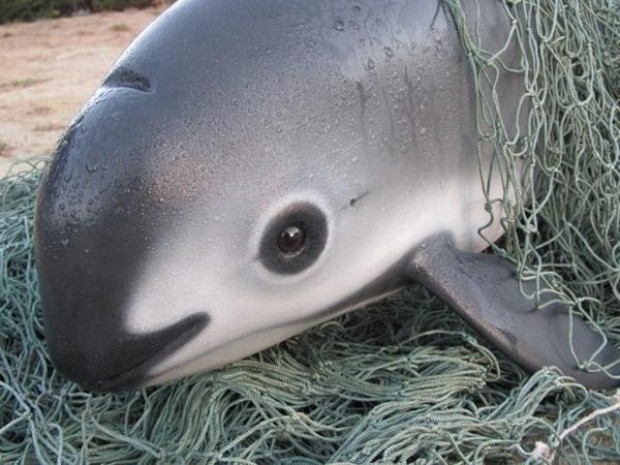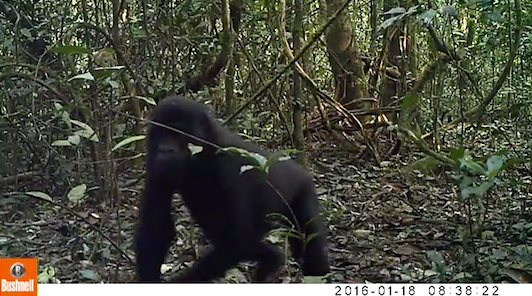The vaquita is the world’s smallest porpoise and critically endangered. The picture above is what people think the vaquita looks like.
The only place vaquitas are found are in the Gulf of California and now Mexico has begun testing unmanned drones that could help it save the critically endangered porpoise. The species is threatened because of illegal fishing in the upper Sea of Cortez.
Alejandro del Mazo, an assistant prosecutor with Mexico’s environmental protection agency, said on Monday he hopes to have three drones patrolling the vaquita’s habitat in coming months. The sea, also known as the Gulf of California, is the only place vaquitas are found.
We are considering the use of advanced technology, because drones would allow us to have permanent aerial patrols in the area and be able to react much more efficiently and quickly.”
Fewer than 100 of the shy, elusive porpoises remain.
The vaquita is threatened by illegal gillnet fishing for totoaba, a large fish whose swim bladder is prized by chefs in China. Nets used by fishermen can trap the tiny porpoises, commonly about 5 feet (1.5 meters) long.
Del Mazo said Mexican authorities last year arrested 17 people for trafficking in totoaba bladders.
Luis Fueyo, the head of Mexico’s national protected areas, said Mexico also is increasing cooperation with U.S. authorities, given that dried totoaba bladders often are clandestinely shipped through California and then to China.
Mexican authorities have proposed a $37 million plan that would ban gillnet fishing in the upper gulf. The plan could be implemented in March following mandatory public consideration.
An area around the mouth of the Colorado River Delta already is protected, but the new proposal would expand the area closed to net-fishing southward to include almost all of the vaquitas’ known range.
The plan presented by the Agriculture and Fisheries Department would pay some fishermen to patrol the area to help deter violations of the ban. Some non-threatening net fishing techniques would be allowed during certain months of the year.
The ban initially would be in place for two years.
Luis Fueyo, the head of Mexico’s national protected areas, noted that a longer-range plan is needed.
The vaquita can’t recover in two years, because they only reproduce every two years, and only 25 of those left are of reproducing age…In order to recover a population of 5,000 individuals, there will have to be a long range plan of 20 or 30 years.”
Experts agree that trying to breed vaquitas in captivity isn’t an option because it would not be feasible to capture or hold a sufficient number of them.
Furthermore, with so few vaquitas spread over such a wide area, chasing down and catching them would risk killing off the few remaining individuals.
Greenpeace is one of the organizations hoping to get laws changed in Mexico to better protect the vaquitas. Here are some facts the organization has about the endangered species.
- It’s one of the two smallest cetaceans in the world, just managing to nudge about 1.5metres long on a good day
- Its name means ‘little cow’, though it is also called the ‘desert porpoise’ as it lives near arid Baja California. They are the only porpoises found in warm waters.
- It was only described by science in 1958.
- It has a tiny geographic range, at about 4,000 km2 (about the size of Cornwall) it’s amongst the smallest of any marine mammal.
- It’s possibly one of the cutest sea mammals around (with dark eye patches giving it apassable panda look), although very few people have ever gotten a good look at a live vaquita…
There are less than a hundred vaquitas left on the planet, and humans are reducing that number by a staggering 17% each year!
Vaquitas are caught and killed as bycatch in a fishery targeting fish called totoaba. The swim bladders of the totoaba are prized as a delicacy for soup in China so there’s lucrative financial incentive for illicit fishing.
It just so happens that totoaba are about the same size as a vaquita, which is really bad news for the porpoises when indiscriminate gillnets are used that catch them, too.
One of the reasons why it’s so difficult to save the vaquita is because of the small range where they live. Many of the recognisable marine critters at greatest risk of extinction, such as hammerhead sharks, whale sharks, sea turtles & manta rays have vast ranges, and are much trickier to protect fully from human impacts.
In fact, in 2005 a marine protected area was designated specifically to protect this tiny porpoise, covering half of its range. But the protected area is surrounded by heavily-fished areas, and ongoing fishing both legal and illegal is killing more and more porpoises.
Greenpeace points out that in this generation alone, we’ve already seen the extinction of the Baiji, a Chinese river dolphin.
Other species are declining fast thanks to humanity, with ship strikes, pollution, habitat destruction, and irresponsible fishing taking an increasingly heavy toll. The vaquita is top of the list, but the future is also bleak for the Maui’s dolphin, the North Atlantic right whale, the Ganges river dolphin, the Western Pacific gray whale, the Irrawaddy dolphin and many more.
h/t: Associated Press, Greenpeace
Photo credit: Greenpeace.org





Comments